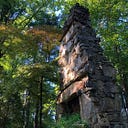Member-only story
Retrieving History in Rebecca Hall and Hugo Martínez’s “Wake”
Over the last couple of posts, I’ve been looking at Rebecca Hall and Hugo Martínez’s Wake: The Hidden History of Women-Led Slave Revolts. Today, I want to conclude this series by looking at some of the panels in the last chapter of Wake. Entitled “Ancestry in Progress,” the final chapter brings together the threads that Hall and Martínez weave throughout the text, and as I have discussed previously, they do this in a masterful manner that showcases the powerful manner in which graphic novels work to engage us as readers not just with the direct narrative of a text but also with the themes and ideas that course through the text’s veins.
The opening page of chapter 10 contains four panels, three small panels on the top and a larger panel on the bottom. The three panels at the top zoom in from the New York skyline in the first panel to the Empire State Building in the second panel to Hall standing on one of the eagle gargoyles on the building as she looks out at the city in the third panel. Here, we see Hall gazing at the city where she grew up, the city that she speaks about in chapter 1, saying that even though she grew up in New York she never heard the full history of the city, the role that the enslaved men, women, and children played in its foundation.
